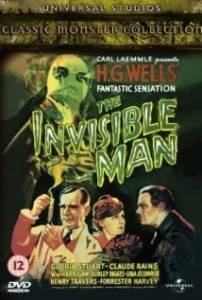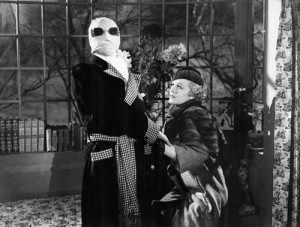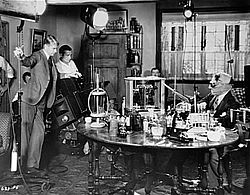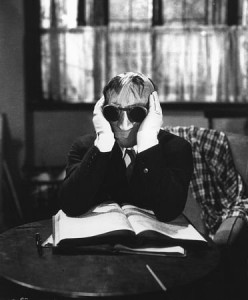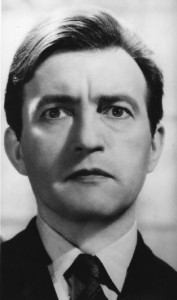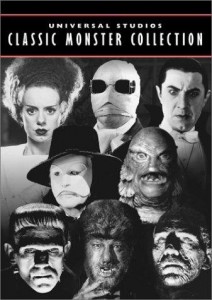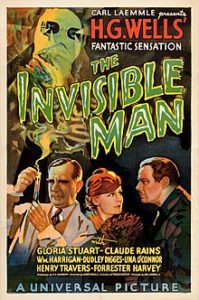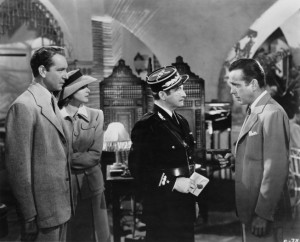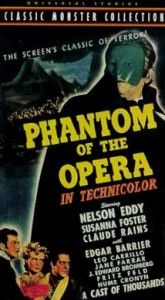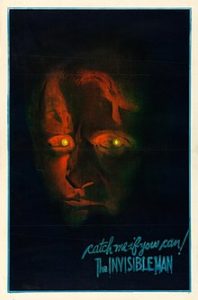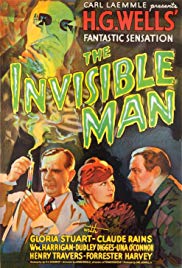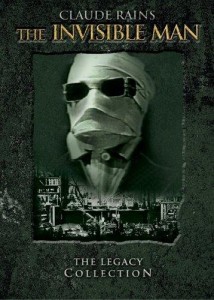The Invisible Man ***** (1933, Claude Rains, Gloria Stuart, William Harrigan, Henry Travers, E E Clive, Una O’Connor) – Classic Movie Review 778
The Invisible Man (1933) is one of the great Universal horror movies. Claude Rains became an overnight star as scientist Dr Jack Griffin, who invents an invisibility serum and turns himself invisible, but then terrorises the Sussex countryside.
The Invisible Man (1933) is one of the great Universal Studios Thirties horror movies. James Whale, the British director of Frankenstein and The Bride of Frankenstein, proves just the man to bring H G Wells’s famous science fiction horror fantasy to the screen, effectively realising the story in a most inspired and imaginative fashion.
Claude Rains became an overnight success as a movie star as Dr Jack Griffin, the scientist who invents an invisibility serum and turns himself invisible, but then terrorises and rampages through the Sussex countryside as an invisible killer when his formula starts to drive him dangerously insane. The role was rejected by Boris Karloff because the main actor spends most of his screen time covered by bandages and is not actually seen clearly till the very end of the film, and then for only a brief time.
Dr Griffin was conducting his own experiments while working in the laboratory of Dr Cranley (Henry Travers), but takes off to a room at the nearby Lion’s Head Inn to try to reverse his experiment making himself invisible, worrying Cranley’s daughter Flora (Gloria Stuart), understandably since his drug has made him violent.
The Invisible Man was Rains’s first American film appearance, prompting his film career to take off. Rains’s instant movie celebrity mirrors Karloff’s own rise to stardom in Frankenstein, a non-speaking role rejected by Bela Lugosi. However, another reason Karloff withdrew was because producer Carl Laemmle Jr had tried to cut Karloff’s contractual salary too many times.
Once James Whale was assigned to direct the film to replace Cyril Gardner, Rains was in as his first choice to play Griffin, though the studio was considering Chester Morris, Paul Lukas and Colin Clive.
R C Sherriff’s nimble screenplay is full of tension as well as welcome, well-placed flashes of humour, capturing the spirit of the novel, and largely keeping the story’s basic framework and the characters’ names, though making several significant changes. But there had been problems in developing the script, which held the film up and in June 1932 it was called off temporarily. Philip Wylie and Preston Sturges’s work on the script was considered unsatisfactory and they were taken off the project. Later, H G.Wells said that, while he liked the picture, he had one grave fault to find with it. ‘It had taken his brilliant scientist and changed him into a lunatic, a liberty he could not condone.’
The visual effects (devised by John P Fulton, John J Mescall and Frank D Williams) may look a bit basic now but they still are charming and they were very impressive for the movie’s era, and are partly credited for the film’s success. The effect of the Invisible Man with no clothes was achieved by using wires, and for when he had some of his clothes on or was taking his clothes off, Rains was shot in a black velvet suit against a black velvet background with the shot combined with another shot of the location using a matte process.
Arthur Edeson and John J Mescall’s black and white cinematography, Charles D Hall’s production designs and the score by Heinz Roemheld, W Franke Harling (composer: stock music) and Gilbert Kurland (music supervisor) all add to the excitement and class the film provides.
It is great too that Whale rounds up the usual suspects for his cast: Gloria Stuart as Flora Cranley, William Harrigan as Dr Arthur Kemp, Henry Travers as Dr Cranley, E E Clive as Constable Jaffers, Una O’Connor as Jenny Hall, Forrester Harvey as Herbert Hall, Dudley Digges as Chief Detective, Dwight Frye as a reporter, Holmes Herbert, Harry Stubbs, Donald Stuart, Merle Tottenham, Walter Brennan as a man whose bicycle is stolen by Griffin, and John Carradine, acting as Peter Richmond, as a Cockney informer.
The movie was Universal’s most successful horror film since Frankenstein, and spawned several sequels and spin-offs, mostly unrelated to the story in Wells’s 1897 science fiction novel. The first sequel, The Invisible Man Returns was released in 1940, with Vincent Price as a new Invisible Man and John Sutton as the brother of Claude Rains’s character.
The Universal series is: The Invisible Man (1933), The Invisible Man Returns, The Invisible Woman, Invisible Agent, The Invisible Man’s Revenge, Abbott and Costello Meet Frankenstein, Abbott and Costello Meet the Invisible Man (1951) and The Invisible Man (2020).
There is also Hollow Man, Hollow Man 2, Griffin, The Nobody, Memoirs of an Invisible Man and The Invisible Mouse.
In 2019 it was announced that Leigh Whannell is helming Blumhouse and Universal’s reboot of The Invisible Man, originally announced with Johnny Depp to star as part of Universal’s Dark Universe, scrapped after the rocky reception to 2017’s The Mummy.
The Invisible Man (2020) premiered in the US on 24 February 2020 and was released on 28 February 2020 in the US and UK. Elisabeth Moss, Oliver Jackson-Cohen, Harriet Dyer, Storm Reid and Aldis Hodge star.
Claude Rains (10 November 1889 – 30 May 1967) is also memorable in Casablanca, Phantom of the Opera, Notorious, The Adventures of Robin Hood (1938), Mr Smith Goes to Washington (1939), The Wolf Man (1941), Now, Voyager (1942) and Kings Row (1942).
Check them all out: Dracula (1931), Frankenstein (1931), The Bride of Frankenstein (1935), Dracula’s Daughter (1936), Son of Frankenstein (1939), The Invisible Man Returns (1940), The Invisible Woman (1940), The Wolf Man (1941), The Ghost of Frankenstein (1942), Invisible Agent (1942), Frankenstein Meets the Wolf Man (1943) and Son of Dracula (1943).
The Invisible Man was shot from June to August 1933 at Universal Studios, interrupted near the end by a small fire that burnt an exterior set, and released on 13 November 1933 with the sell-lines ‘Catch me if you can!’ and ‘H.G. Wells’ Fantastic Sensation’.
© Derek Winnert 2014 Classic Movie Review 778
Check out more reviews on http://derekwinnert.com/

